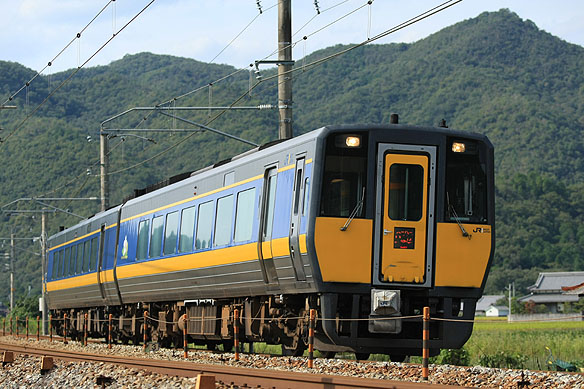Background and overview
JR West developed kiha187-500 series DMU trains in 2003 to displace kiha181
series DMU used on "Inaba" intercity services at the completement
of the project implemented by Tottori prefecture for the shortening the
journey time of the Inbi line between Tottori and Chizu. Kiha187-500 series
consists of 2 types of end vehicles, class kiha187-500 having a toilet
and kiha187-1500 having a designated smoking room, and they can also make
3-car or 4-car sets by the combination of these vehicles. Four 2-car sets
were delivered in 2003.
Car body
They have 2845mm wide body incorporating light weight stainless-steel construction
and feature the improved 26mm thick floor construction which consists of
deck plates, floor fillings, and floor coverings compared to kiha187-0
series 6.5mm thick floor which consists of stainless-steel plates and floor
coverings to improve noise and vibration insulation. The bodies are unpainted
and have a blue wide band around windows and yellow-coloured narrow bands
between blue wide band and unpainted body. The cab section having a gangway
is gabled and two plane windscreens having a cluster of a rectangle-shaped
sealed beam headlight and a rectangle-shaped LED trail light behind them
are fitted on both side of the gangway door. A built-in classification
3-colour LED headboard is fitted on the gangway. The area below the windscreens
is painted in yellow to ensure visibility of the train travelling at high
speed and the upper area in dark gray. Anti-fall plates between vehicles
are also introduced excepting the cab end. They are equipped with a 1000mm
wide single leaf sliding door located at the rear of class kiha187-500
vehicles and the front of class kiha187-1500 vehicle, and wide fixed double-glazed
windows aligned two seating bays. The stepped door is not featured because
their floor level is 1160mm from the rail to realize a low centre of gravity.
A LED destination display is fitted on each side of the body. Air conditioners,
WAU707A, increased to two using R407C refrigerant are fitted on the roof.
They employed tight lock couplers having automatic jumper coupler to ease
rush-up operations.
Bogies
They are equipped with powered bogies, WDT61A, incorporating 1-axle drive
and featuring bolster-less secondary suspension, coil spring primary suspension
with cylindrical laminated rubber, single link draw gear, and tilting mechanism.
These bogies adopt secondary suspensions with improved stiffness, lateral
dampers having improved attenuation and optimized mounting position, the
yaw dampers to ensure smooth ride characteristics even at 120km/h. Tilting
mechanism employs the pneumatic cylinder to prevent the sudden tilting
and the liner motion guide to provide smooth tilting motion by reducing
the friction. Their bogie frame employs bow-shape to fit the tilting frame
and the liner motion guide. Their bogies employ single-tread brake devices
adopting automatic gap-adjusting unit.
Traction unit and ancillary equipments
They are powered by two four-cycle straight-six diesel prime movers, SA6D140-H-1, with a power output of 450PS employing the turbo charger powered by the flow of exhaust gas and the intercooler. Their hydraulic transmission gear classified into DW21 features a three-member one-stage torque converter, multi-plate wet clutch, and four-staged direct coupled range. A radiator and heat exhaust fan unit are miniaturized to be fitted under the floor to increase seating capacity. They aim to reduce manufacturing cost and ease maintenance by standardizing equipments with JR West's EMU trains in particular the 223 series by employing electrified and standardized equipments to realize beltless. An engine driven generator, WDM111, is powered by one of prime movers via a Constant Speed unit supply three-phase 440V to the air conditioner and the electric heating. This 440VAC is also stepped down to 100VAC or rectified to 100VDC to supply to the control circuit and the auxiliary equipments A engine driven air compressor, WCW800, is connected to a prime mover with gears. Kiha187-500 series adopt the transmission control unit, TICS (Train Information Control System), which runs on PLC (Programmable Logic Controller) to reduce trains lines and relays. The brake system is changed into the electric command pneumatic brake with jake braking. If the jake braking is no longer able to provide the specified braking force, the pneumatic braking supplements it. All vehicles are equipped with ATS-SW onboard signaling system beneath the floor, and ATS-P onboard signaling system in the equipment room on the floor.
Accommodation
Seating accommodation consists of 2+2 abreast adjustable reclining with
970mm seating pitch. Prefabricated panels were employed for the interior
providing a sense of warmth, wood-based materials were used for handrails
and window frames to give a high-class feeling. A door chime is fitted
in the door header of each sliding door. Class kiha187-10 vehicles are
equipped with a universal access toilet employing the vacuum toilet system
located at the end of the body, and class kiha187-1010 a designated smoking
room located at the end. As for the device of driving cab, two handle master
controller is adopted same as EMU trains.
Operations
They entered "Super Inaba" intercity services linking Okayama
and Tottori in October 2003. Kiha187-500 series are now used on "Super
Inaba". |
|

